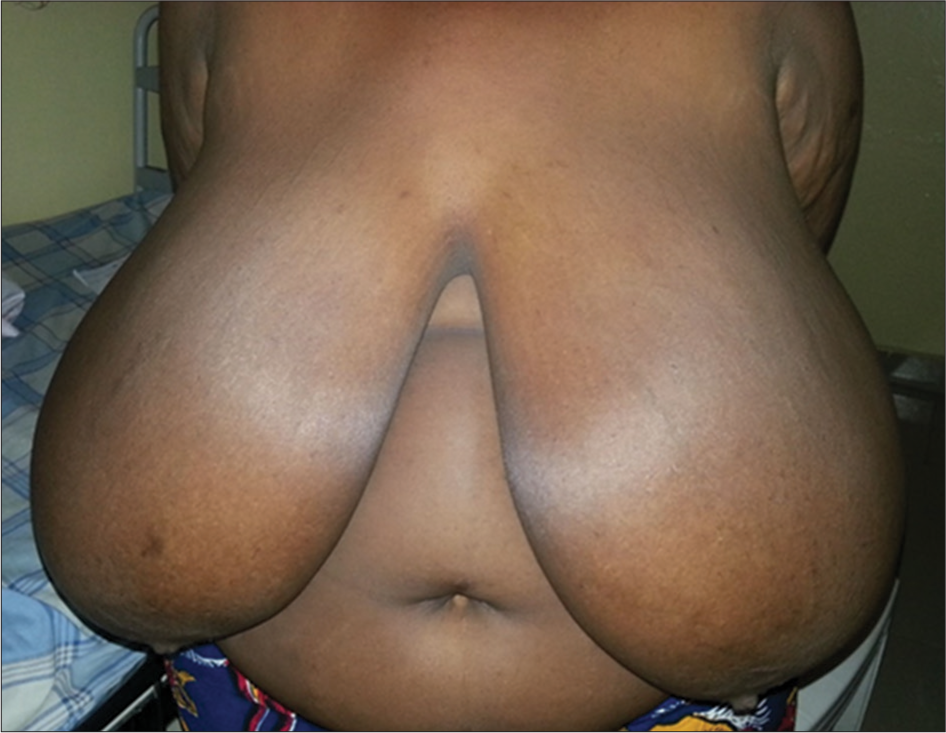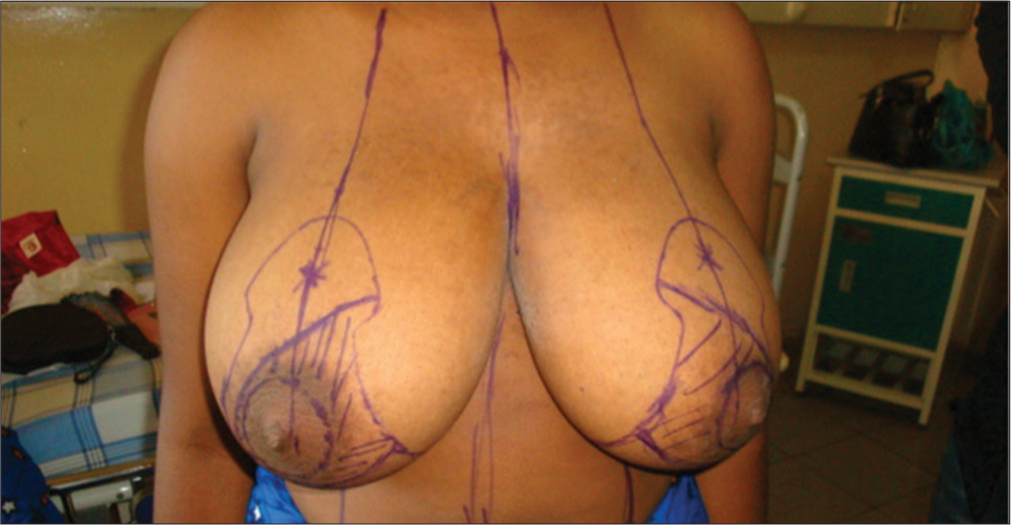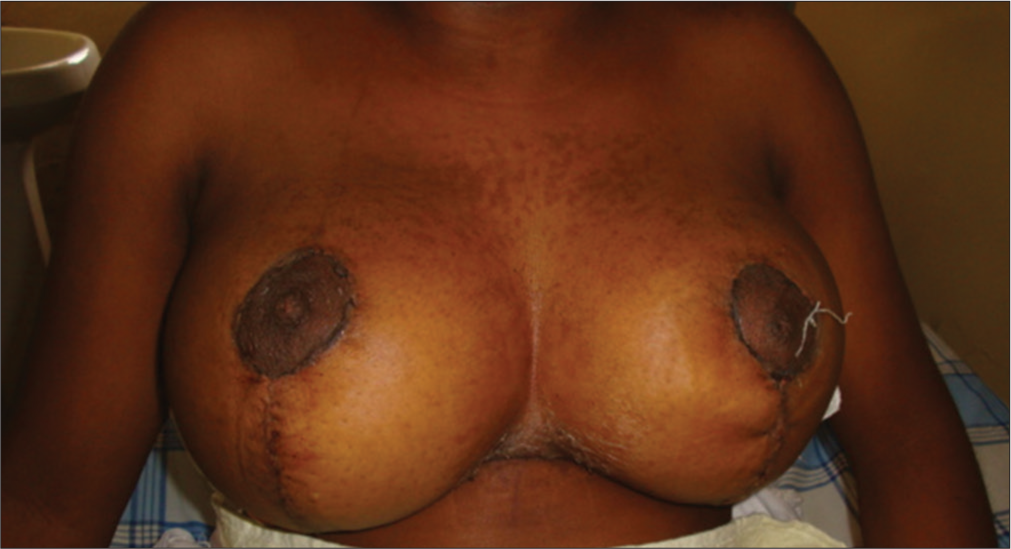Translate this page into:
Reduction mammaplasty at a teaching hospital in North Central Nigeria – A 12-year audit

*Corresponding author Amina Ibrahim Abubakar, Department of Surgery, University of Abuja, Abuja, Nigeria. amina.abubakar@uniabuja.edu.ng
-
Received: ,
Accepted: ,
How to cite this article: Abubakar AI, Ehighibe AP, Okpechi S, Sabo VY. Reduction mammaplasty at a teaching hospital in North Central Nigeria – A 12-year audit. Ann Med Res Pract. 2024;5:1. doi: 10.25259/ANMRP_1_2023
Abstract
Reduction mammaplasty (RM) is the 7th most common surgery performed by plastic surgeons worldwide. This trend is not reflected by literature in the African subcontinent. In this article, we present the demographic characteristics of patients who had reduction mammoplasty in a teaching hospital in North Central Nigeria. In a retrospective study, we present data from 8 RMs performed over 12 years. Fifty per cent of our patients were single, and the patient age ranged from 18 to 53 years, with a mean age of 32 ± 12.2 years. Our patients presented with the classic symptoms of breast hypertrophy: chest pain, back pain, and mastalgia. The mean nipple areola distance was 37.2 ± 5.9 cm. Six (75%) of our patients had superior pedicle RM, while the other two had breast amputation and free nipple grafting. Fifty per cent had inverted T skin pattern resection and the rest had a vertical scar. We recorded no complications in three of our patients. We have found the superomedial pedicle to be quite versatile and reliable, with a short learning curve even with very large breasts. Patient satisfaction post-operative was mixed in three patients and negative in one patient. A lot of education is necessary to ensure that patients are aware of RM and that the procedure must be made affordable.
Keywords
Reduction mammoplasty
Gigantomastia
Nigeria
INTRODUCTION
Although concern for excessively large breasts was documented as early as the period of Paulus of Aegina (635-90),[1] the earliest documented case of breast reduction for women was in the past two decades of the 19th century.
Reduction mammoplasty is the volumetric reduction of the enlarged breast, which was initially aimed at relieving the debilitating physical symptoms of macromastia/gigantomastia[2], but the emphasis now includes preservation of function and improving esthetics.[3] These symptoms include pain and postural changes, among others and can lead to reduced quality of life and psychological problems with its attendant emotional liabilities. It has proven to be more effective than other conservative methods such as weight loss, supportive bras, and physical therapy.
Reduction mammoplasty (RM) is the 7th most common surgery performed by plastic surgeons worldwide[4], with over 78,000 performed in the United States alone. This statistic is not reflected in surgeries done in Africa either due to poor data collection or unavailability of experts or resources. This article aims to present our 12-year experience in reduction mammoplasty, discussing the patient demographics, presentation, and various surgical methods used in comparison with data from other parts of Africa, as well as exploring the reasons for low numbers of RM surgeries.
CASE SERIES
This study is a retrospective study of all patients who have had RM at the University of Abuja Teaching Hospital (UATH) over 12 years (January 2008–December 2020). The hospital is a tertiary referral hospital that draws patients from North Central, North East, and North West Nigeria. Ethical approval for this study was obtained from the UATH Health Research and Ethics Committee.
The patient records were retrieved from the hospital records and information department, and details concerning their age, marital status, symptomatology, type of surgery, and complications were extracted. The patients were also contacted over the phone to determine their level of satisfaction with the procedure outcome – size, nipple sensation, and improvement of symptoms.
The data were analyzed with Microsoft Excel and interpreted accordingly.
RESULTS
Eight cases of RM were performed over the 12 years. The youngest patient was 18 years old, and the oldest was 53 years old, with a mean age of 32.9 ± 12.2 years [Table 1]. Four (50%) of our patients were single, and one was a widow. They all had classical symptoms associated with breast hypertrophy; back pain, chest pain, and mastalgia were the presenting complaints, with 50% complaining of both chest and back aches.
| S. No. | Age (years) | Pre-op pedicle length (cm) | |
|---|---|---|---|
| Rt | Lt | ||
| 1. | 18 | 35 | 34 |
| 2. | 23 | 40 | 43 |
| 3. | 24 | 33.2 | 33 |
| 4. | 27 | NA | NA |
| 5. | 34 | NA | NA |
| 6. | 38 | 32 | 30 |
| 7. | 46 | 42 | 41 |
| 8. | 53 | 40 | 43 |
| 32.9±12.2 | 37.1±4 | 37.2±5.9 | |
SD: Standard deviation, Rt: Right, Lt: Left
The nipple areola distance measurements for two patients were lost. The mean nipple-areola complex (NAC) distance on the right was 37.1 ± 4 cm, while on the left, it was 37.2 ± 5.9 cm [Table 1]. Six (66%) of these patients had a superomedial pedicle breast reduction, and two had breast amputation and free nipple grafting. Skin resection was a vertical scar in 50% while the rest were with an inverted T scar.
Three patients (37.5%) recorded no postoperative complication, and the others recorded complications of nipple necrosis (12.5%), hematoma (12.5%), wound dehiscence (12.5%), keloids (12.5%), and nipple depigmentation (12.5%). Only one patient (12.5%) was completely dissatisfied with her surgical outcome. Four patients (50%) were satisfied with their outcome, while 37.5% returned a mixed satisfaction.
DISCUSSION
The oldest and largest series for RM in Nigeria was by Akpuaka and Jiburum in Enugu[5], who recorded 60 cases over ten years, translating to six patients a year. Since then, other series have recorded small numbers.[2,6] Our number of eight cases in 12 years, which is 0.6 patients a year, is comparable with the finding in a recent series in Enugu, 15 patients in 10 years. This is a drastic contrast to the findings of Agbenorku et al., who reported 63 patients in 10 years.[7] The reason for such low numbers in Nigeria may be because several centers offer RM; thus, patients have spread around, and there is the added reason of financial constraints with the patients. Symptomatic reduction mammoplasty is covered by the health insurance scheme in Ghana, unlike in Nigeria, where patients still pay out of pocket. Although 50% of our patients were single, the mean age of patients in this series was 32.9 ± 12.2 years, which is higher than in the Isiguzo et al. and Agbenorku et al. series, but it is ten years less than in the US.[2,7] All the unmarried patients were above the mean study age. The concept of body image and reception to body altering surgery differs from region to region. The northern parts of Nigeria are more conservative in thinking, which may explain the age difference between married and unmarried women.
The symptoms presented by our patients are similar to those recorded in other series. Our youngest patient recorded several missed school days, which prompted the surgery at such a young age.
The average distance of the NAC in our study was 37.1 ± 5.9 cm, which falls within the acceptable distance for pedicled reduction mammoplasty.[8] Three of our patients had breast hypertrophy with massive ptosis (NAC distance > 40 cm) [Figure 1]. Two of them had breast amputation with free nipple grafting. The third one had superior pedicle reduction mammoplasty.

- A 57-year-old with gigantomastia.
Although the most frequently used technique of RM is inferior pedicle,[9] superior pedicle reduction mammoplasty [Figure 2] is practiced in our center due to the short learning curve[10], and the vertical scar skin resection is more acceptable to patients [Figure 3]. We did not have any incidence of bottoming out in the four patients; for whom we employed this closure method.

- Pre-operative superior medial reduction mammaplasty skin marking.

- Post-operative images of vertical scar skin closure.
Our complications were minor but occurred in five of our patients, but these patients returned a mixed reaction when asked about outcome satisfaction. This we adduced to be due to the emotional trauma resulting from the complication. All our patients had relief from their symptoms after surgery. One of our patients declined nipple reconstruction in our facility and opted for a second opinion.
CONCLUSION
Although there has been an increase in the number of plastic surgeons in Nigeria, the number of RM performed has not been commensurate. The significant relief in symptoms offered by this procedure makes it an important aspect of plastic surgery practice. Incorporating RM into the health insurance scheme in Nigeria, along with increased awareness of this service among the population will help improve access by patients.
Ethical approval
Ethical approval for this study was obtained from the UATH Health Research and Ethics Committee.
Declaration of patient consent
Patient’s consent is not required as patients identity is not disclosed or compromised.
Conflicts of interest
There are no conflicts of interest.
Use of artificial intelligence (AI)-assisted technology for manuscript preparation
The authors confirm that there was no use of artificial intelligence (AI)-assisted technology for assisting in the writing or editing of the manuscript, and no images were manipulated using AI.
Financial support and sponsorship
Nil.
References
- Reduction mammoplasty in a developing country: A 10-year review (2001-2010) at the national orthopaedic hospital, Enugu. Niger J Surg. 2015;21:21-5.
- [CrossRef] [PubMed] [Google Scholar]
- Surgical anatomy of reduction mammaplasty: A historical perspective and current concepts. South Afr J Surg. 2017;55:22-8.
- [Google Scholar]
- International survey on aesthetic/cosmetic procedures performed in 2019. Available from: https://www.isaps.org/es/discover/about-isaps/global-statistics/reports-and-press-releases/global-survey-2019-full-report-and-press-releases-english/ [Last accessed on 2022 Nov 02]
- [Google Scholar]
- Reduction mammaplasty by the inferior pedicle technique: Experience with moderate to severe breast enlargement. West Afr J Med. 1998;17:199-201.
- [Google Scholar]
- Reduction mammoplasty: The experience in Ile-Ife, Nigeria. Niger J Med. 2007;16:261-7.
- [Google Scholar]
- Reduction mammoplasty in a developing country: A guideline for plastic surgeons for patient selection. Aesthetic Plast Surg. 2012;36:91-6.
- [CrossRef] [PubMed] [Google Scholar]
- Superior pedicle breast reduction for hypertrophy with massive ptosis. J Plast Reconstr Aesthet Surg. 2011;64:500-7.
- [CrossRef] [PubMed] [Google Scholar]
- Inferior pedicle reduction In: Stephen JM, ed. Plastic surgery (2nd ed). Philadelphia, PA: Saunders; 2006. p. :601-30.
- [Google Scholar]







